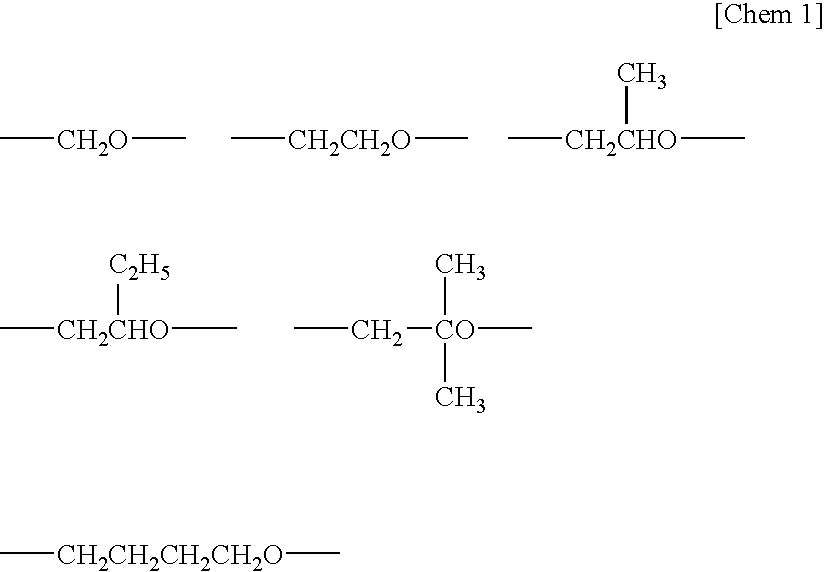Moisture curable polymer having SiF group, and curable composition containing the same
a curable polymer and moisture technology, applied in the direction of polyether adhesives, adhesive types, adhesives, etc., can solve the problems of inferior curability of organic tin catalysts and many of these catalysts, and achieve the effect of superior curability
- Summary
- Abstract
- Description
- Claims
- Application Information
AI Technical Summary
Benefits of technology
Problems solved by technology
Method used
Image
Examples
synthesis example 1
[0188]Using polyoxypropylenediol having a molecular weight of about 2,000 as an initiator, polymerization of propylene oxide was carried out with a zinc hexacyano cobaltate glyme complex catalyst to obtain polypropylene oxide having a terminal hydroxyl group and having a number average molecular weight of about 14,500 (in terms of the polystyrene equivalent molecular weight determined using: HLC-8120GPC manufactured by Tosoh Corporation as the liquid feeding system; TSK-GEL H type manufactured by Tosoh Corporation as the column; and THF as the solvent). Subsequently, a methanol solution of 1.2 times equivalent of NaOMe based on the hydroxyl group of this hydroxyl group-terminated polypropylene oxide was added thereto, and methanol was distilled off. Further, allyl chloride was added thereto to convert the terminal hydroxyl group into an allyl group. The unreacted allyl chloride was removed by devolatilization under reduced pressure. After 300 parts by weight of n-hexane and 300 part...
example 1
[0190]After azeotropic dehydration of 100 parts by weight of the dimethoxymethylsilyl group-terminated polyoxypropylene based polymer (B-1) obtained in Synthesis Example 1 was carried out with toluene, 2.5 parts by weight of a BF3 diethyl ether complex was slowly added dropwise and mixed at room temperature while stirring thoroughly under a nitrogen gas stream. The reaction temperature was then elevated to 50° C., and the reaction was allowed for 2 hrs. The reaction product was collected, and the 1H-NMR spectrum was determined, in which the peak (s, 0.1 ppm) corresponding to Si—CH3 of the dimethoxymethylsilyl group of the polymer (B-1) used as the raw material disappeared, while the peak (t, 0.3 ppm) representing Si—CH3 of the difluoromethylsilyl group appeared. Accordingly, it was verified that the dimethoxymethylsilyl group in the polymer (B-1) was converted quantitatively into a difluoromethylsilyl group. Devolatilization under reduced pressure was carried out using a vacuum pump...
example 1 ′
Example 1′
[0191]A difluoromethylsilyl group-terminated polyoxypropylene based polymer (A-1′) having a number average molecular weight of 16,000 was obtained by a similar operation to Example 1 except that the operation of removal of the BF3-derived components using the vacuum pump was not carried out. The amount of B included in the polymer (A-1′) was about 960 ppm.
PUM
| Property | Measurement | Unit |
|---|---|---|
| glass transition temperature | aaaaa | aaaaa |
| glass transition temperature | aaaaa | aaaaa |
| glass transition temperature | aaaaa | aaaaa |
Abstract
Description
Claims
Application Information
 Login to View More
Login to View More - R&D
- Intellectual Property
- Life Sciences
- Materials
- Tech Scout
- Unparalleled Data Quality
- Higher Quality Content
- 60% Fewer Hallucinations
Browse by: Latest US Patents, China's latest patents, Technical Efficacy Thesaurus, Application Domain, Technology Topic, Popular Technical Reports.
© 2025 PatSnap. All rights reserved.Legal|Privacy policy|Modern Slavery Act Transparency Statement|Sitemap|About US| Contact US: help@patsnap.com

